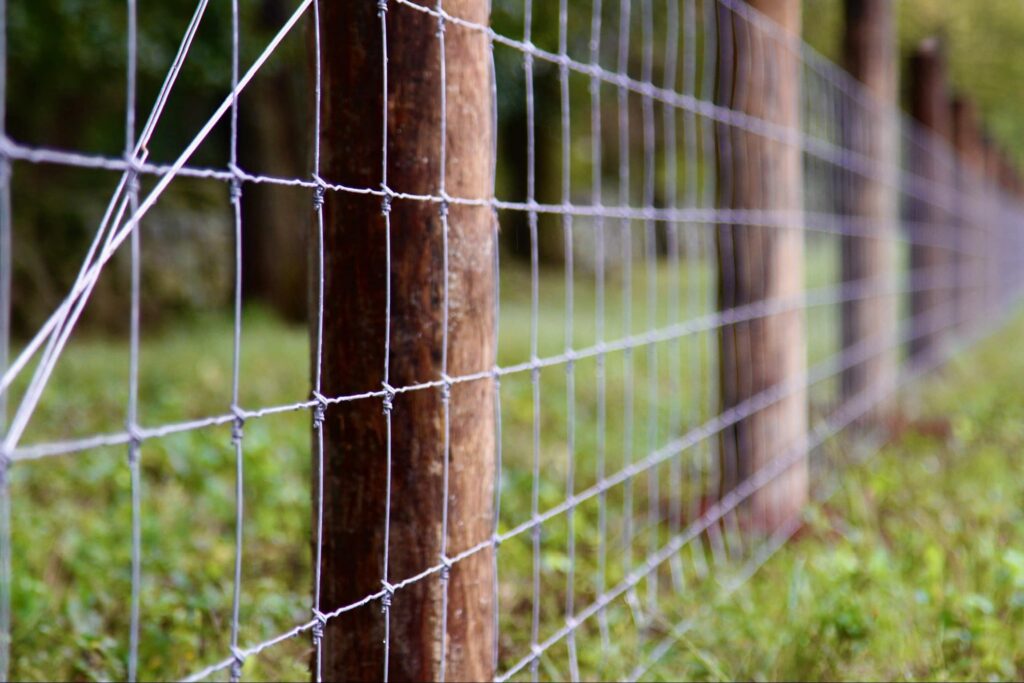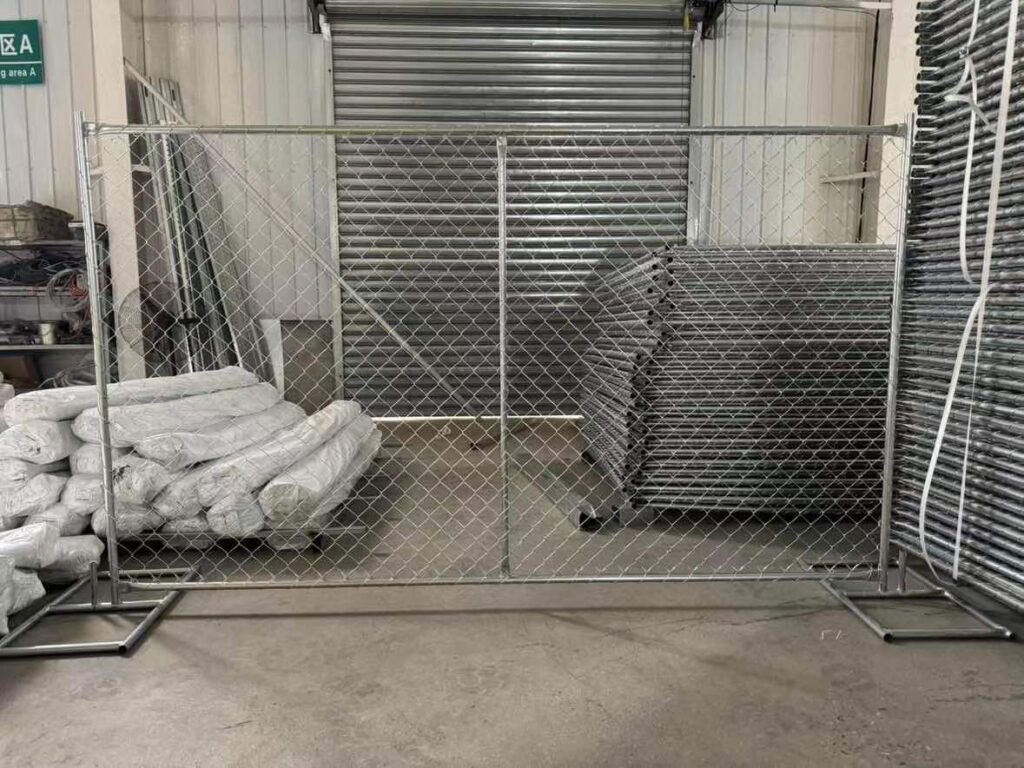Construction site security is a crucial part of project management. It protects valuable equipment, materials, and most importantly – human lives. By implementing strong security measures, we can prevent theft, vandalism, and unauthorised access while also ensuring workplace safety regulations are followed.
Why Choose Mesh Fencing for Construction Site Security?
Mesh fencing is an essential security solution for construction sites. It provides a physical barrier that clearly defines the boundaries of the construction zone and controls access points. These versatile structures are both durable and practical, offering:
- Enhanced Site Protection – Creating a clear separation between public spaces and work areas
- Controlled Access Management – Establishing designated entry points for authorised personnel
- Risk Mitigation – Reducing liability concerns by properly containing the site

The benefits of mesh fencing go beyond just basic security. It also provides a comprehensive safety solution that:
- Prevents unauthorised entry to hazardous areas
- Contains construction debris within the site boundaries
- Maintains a professional appearance of the site
- Supports compliance with safety regulations
- Allows for quick installation and reconfiguration as needed
This proven security measure has become standard practice across construction projects. It reflects its effectiveness in creating safer work environments while also protecting public welfare.
Understanding Mesh Fencing in Construction Security
Mesh fencing systems are made with strong materials specifically designed to secure construction sites. The main part of the system, welded wire mesh, is made up of high-tensile steel wires that cross each other at regular intervals, forming a sturdy barrier. These mesh panels have small openings—usually measuring 50mm x 150mm—making them hard to cut or climb.
How Mesh Fencing Maintains Its Strength
The strength of mesh fencing comes from its special design features:
- Anti-climb mesh panels: These panels have vertical wires that extend above the top rail, making it difficult for anyone to climb over.
- Tamper-proof framework: The heavy-duty galvanised steel framework is built to resist tampering and ensure the fence remains intact.
- Reinforced corners: The corner sections of the fence are reinforced to provide extra stability and prevent any bending or collapsing.
- Welded joints: The joints where the panels connect are welded, which stops any separation between the panels and keeps them securely in place.
How Mesh Fencing Enhances Site Security
The way the mesh is arranged also plays a vital role in keeping the site secure:
- Dense mesh patterns: The tightly woven pattern of the mesh prevents intruders from finding places to grip with their toes or fingers, making it harder for them to climb.
- Vertical wire spacing: By having the wires spaced vertically, it becomes challenging for anyone attempting to climb over the fence as they won’t have any footholds.
- Horizontal supports: The inclusion of horizontal supports in the design ensures that each panel remains rigid and doesn’t sag or bend under pressure.
- Galvanised coating: The use of galvanised steel coating protects the fence against rust and corrosion, ensuring its longevity even in harsh weather conditions.
Additional Security Features in Modern Temporary Fencing Systems
Modern temporary fencing systems go a step further by incorporating extra security features such as:
- Anti-tamper fixings: These fixings are designed to prevent anyone from easily removing or tampering with the fence panels.
- Concrete block foundations: By using heavy concrete blocks as foundations for each panel, it becomes extremely difficult for anyone to move or topple them.
- Interlocking panel mechanisms: The panels are designed in such a way that they interlock with each other, creating a stronger barrier that cannot be easily breached.
- High-visibility warning signs: Placing clear and visible signs around the perimeter serves as a deterrent by alerting potential intruders about the presence of security measures.
These security elements work together harmoniously to create an effective deterrent against unauthorised access while still allowing for clear sight lines when monitoring the site. With this design approach, security personnel can easily spot any potential breaches or suspicious activity occurring around the perimeter.
Additionally, modern mesh fencing systems often incorporate advanced features like security screws into their design. These screws are specifically engineered to enhance security by making it significantly more difficult for unauthorized individuals to remove or tamper with fence panels.
Read more at: Benefits of Using Temporary Scaffolding with Site Mesh
Enhancing Security with Mesh Fencing Features
Modern mesh fencing systems incorporate advanced security components to create robust barriers against unauthorised access.
1. Anti-Lift Brackets
Anti-lift brackets serve as critical anchoring points, preventing attempts to lift or remove fence panels. These brackets secure panels firmly to posts at strategic intervals, creating a tamper-resistant perimeter.
2. Lockable Couplers
Lockable couplers add an extra layer of protection through specialised connection points:
- Require specific tools for installation and removal
- Feature unique locking mechanisms resistant to standard tools
- Create permanent connections between fence sections
- Prevent quick dismantling attempts
3. Secure Access Points
The integration of secure access points maintains site security while enabling controlled movement:
- Pedestrian gates with anti-climb tops
- Vehicle access gates with reinforced frames
- High-security locking systems
- Automated entry systems with keycard or code access
- Emergency exit mechanisms compliant with safety regulations
4. Additional Security Elements
Additional security elements enhance the effectiveness of mesh fencing systems:
- Corner reinforcements for structural integrity
- Ground pins for stability on uneven terrain
- Cable ties for supplementary panel attachment
- Warning signs and safety notices integrated into fence panels
These security features work together to create a comprehensive barrier system that protects construction assets while maintaining efficient site operations. The combination of physical deterrents and access control measures establishes a secure perimeter adaptable to various security requirements.
Flexibility and Adaptability of Mesh Fencing on Construction Sites
The lightweight design of mesh fencing creates significant advantages for construction site management. A standard mesh panel weighs between 12-15kg, allowing quick handling by a single worker without heavy machinery requirements.
Key Mobility Features:
- Rapid assembly through simple clip-together components
- Modular design enabling custom configurations
- Single-person installation capabilities
- Easy transportation between work zones
The adaptable nature of mesh fencing systems accommodates various ground conditions through specialised fixing methods:
Surface Protection Solutions:
- Rubber-based temporary feet for finished surfaces
- Concrete blocks for unstable terrain
- Ground pins for soil installation
- Counterweight systems for high-wind areas
These versatile mounting options protect both existing infrastructure and newly completed work while maintaining fence stability. The modular design allows construction teams to expand, contract, or reconfigure the security perimeter as project phases progress.
Site-Specific Applications:
- Multi-level construction requiring frequent repositioning
- Restricted access areas with limited space
- Heritage sites demanding non-invasive installation
- Temporary works requiring daily configuration changes
The quick-connect system enables rapid response to changing site conditions, weather events, or emergency situations. This flexibility proves invaluable for dynamic construction environments where work zones shift frequently and security needs evolve throughout project stages.
Role of Mesh Fencing in Worker and Public Safety
Mesh fencing serves as a critical safety barrier between construction activities and the surrounding environment. The robust design creates a physical boundary that prevents unauthorised individuals from wandering into potentially hazardous work zones.
Key Safety Benefits for Workers:
- Establishes clear work zone boundaries
- Prevents accidental entry into dangerous areas
- Creates designated entry/exit points for better access control
- Reduces liability risks from trespassing incidents
Public Protection Measures:
- Blocks access to heavy machinery and equipment
- Contains falling debris within the construction perimeter
- Prevents children from entering dangerous areas
- Maintains safe distance between pedestrians and construction activities
The strategic placement of mesh fencing panels helps contain various construction materials and debris:
- Flying particles from cutting operations
- Dust from demolition work
- Scattered building materials
- Tools and small equipment
Mesh fencing’s visibility factor plays a vital role in safety awareness. The clear demarcation helps both workers and the public identify restricted areas instantly, reducing the risk of accidents. The height and density of the fence create an effective barrier while allowing natural light and ventilation to pass through, maintaining optimal working conditions for construction personnel.
For urban construction projects, mesh fencing provides additional protection by creating safe pedestrian walkways around the site perimeter, ensuring continuous foot traffic flow while maintaining strict safety standards.
Noise and Dust Control Benefits with Mesh Fencing Accessories
Construction sites in urban areas require effective dust and noise management solutions to maintain positive community relations. Mesh fencing systems equipped with specialised accessories deliver substantial environmental control benefits.
Privacy Screens and Hoarding Solutions:
- Solid shade cloth attachments block direct views into work zones
- Custom-printed hoarding panels showcase project information
- UV-resistant materials ensure long-lasting visibility protection
Dust Control Capabilities:
- Dense mesh screens capture up to 90% of airborne particles
- Vertical coverage prevents dust clouds from spreading to neighbouring properties
- Reduced clean-up requirements for surrounding streets and buildings
Noise Reduction Features:
- Acoustic barrier attachments absorb sound waves
- Multiple layer configurations enhance noise dampening
- Strategic placement around high-activity zones minimises community impact
The integration of these accessories transforms basic mesh fencing into comprehensive environmental control systems. Local councils and environmental regulators often mandate specific dust and noise control measures – mesh fencing with appropriate screens meets these requirements while maintaining site security.
Regular inspection and maintenance of screening accessories, such as privacy screens, ensures optimal performance throughout the project lifecycle. Damaged or loose sections should be promptly repaired to maintain effective dust and noise control.
Durability and Weather Resistance of Temporary Mesh Fencing Solutions
Construction mesh fencing systems are made from strong materials that can handle different weather conditions. The galvanised steel construction offers excellent protection against:
- Rust and corrosion
- UV radiation exposure
- Heavy rain and flooding
- Strong winds and storms
- Temperature changes
Long-lasting Protection with Modern Mesh Panels
Modern mesh panels have a hot-dip galvanisation coating that is 42 microns thick. This coating creates a protective barrier that extends the lifespan of the fencing through multiple projects. As a result, mesh fencing is suitable for both short-term installations and long-term construction periods.
Flexible Rental Options for Construction Companies
Rental options provide construction companies with access to high-quality weather-resistant fencing without the need for a large upfront investment. The rental periods vary based on project requirements:
- Weekly hire for small renovations
- Monthly arrangements for medium-scale builds
- Long-term leasing for major infrastructure projects
Cost-effective Purchase Options for Multiple Sites
For construction companies handling several projects simultaneously or having extended project timelines, purchase options become more economical. The modular design of the fencing allows damaged sections to be replaced individually, ensuring the fence’s structural integrity throughout its lifespan.
Economic and Environmental Considerations in Using Mesh Fencing
Mesh fencing presents significant cost advantages compared to permanent security solutions. The initial investment for mesh fencing systems ranges from 30-50% lower than solid hoarding or permanent fencing options. These savings extend through reduced transportation and installation costs due to the lightweight nature of mesh panels.
The environmental impact of mesh fencing aligns with sustainable construction practices:
- Reduced Material Usage
- Lightweight design requires less raw materials
- Minimal ground disturbance during installation
- Lower carbon footprint in manufacturing
- Reusability Benefits
- Panels maintain structural integrity across multiple projects
- Components can be dismantled without damage
- Modular design allows replacement of individual sections
- Waste Reduction
- No concrete footings required
- Zero excavation waste
- 100% recyclable materials
The rental market for mesh fencing provides additional economic advantages through:
- Elimination of storage costs
- Reduced maintenance responsibilities
- Flexible hire periods matching project timelines
- No depreciation costs to consider
These combined economic and environmental benefits make mesh fencing a responsible choice for construction site security.
Best Practices for Installing and Maintaining Mesh Fencing on Construction Sites
Proper installation and maintenance protocols ensure mesh fencing delivers optimal security and safety performance throughout construction projects.
Essential Installation Guidelines:
- Position fence posts at maximum 3-metre intervals
- Secure panels with anti-tamper fixings at top and bottom
- Install additional bracing on corner sections
- Create level ground surfaces before mounting
- Test gate mechanisms after installation
Critical Maintenance Practices:
- Conduct daily visual inspections for damage
- Tighten loose fixings immediately
- Clean mesh panels to prevent debris build-up
- Replace damaged sections promptly
- Document all maintenance activities
Stability Enhancement Techniques:
- Use concrete blocks for temporary installations
- Apply wind-load calculations for exposed areas
- Install additional support posts in high-traffic zones
- Implement proper drainage around fence lines
- Add stabilising struts on uneven terrain
Regular maintenance checks paired with correct installation methods maximise fence effectiveness and extend service life. A systematic approach to upkeep helps identify potential issues before they compromise site security.
Conclusion
Mesh fencing is a crucial security solution for modern construction sites. Its combination of strong physical barriers, flexible configurations, and built-in safety features provides comprehensive protection for both workers and the public. With its cost-effectiveness, eco-friendliness, and proven success in securing sites, mesh fencing is an essential choice for construction projects.
But mesh fencing offers more than just basic security. It can also help with other site management challenges such as controlling dust and reducing noise. These practical benefits, along with easy installation and maintenance, make mesh fencing a valuable investment for ensuring safety and compliance on construction sites.
By making mesh fencing a standard safety measure, construction companies demonstrate their commitment to professional site management and responsible building practices.

